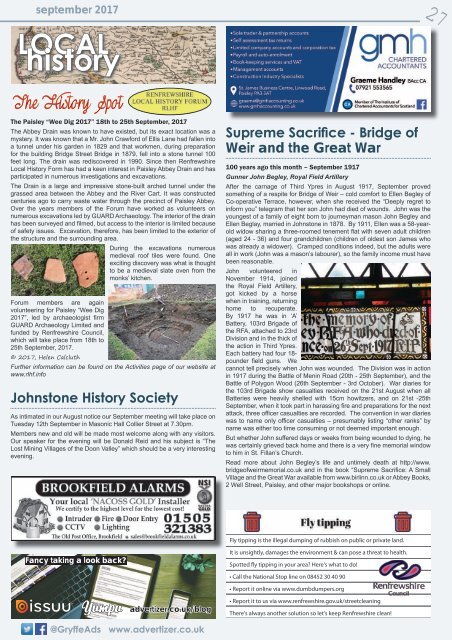276 September 2017 - Gryffe Advertizer
The Advertizer - Your local community magazine to the Gryffe area.
The Advertizer - Your local community magazine to the Gryffe area.
Create successful ePaper yourself
Turn your PDF publications into a flip-book with our unique Google optimized e-Paper software.
september <strong>2017</strong><br />
LOCAL<br />
history<br />
27<br />
The Paisley “Wee Dig <strong>2017</strong>” 18th to 25th <strong>September</strong>, <strong>2017</strong><br />
The Abbey Drain was known to have existed, but its exact location was a<br />
mystery. It was known that a Mr. John Crawford of Ellis Lane had fallen into<br />
a tunnel under his garden in 1829 and that workmen, during preparation<br />
for the building Bridge Street Bridge in 1879, fell into a stone tunnel 100<br />
feet long. The drain was rediscovered in 1990. Since then Renfrewshire<br />
Local History Form has had a keen interest in Paisley Abbey Drain and has<br />
participated in numerous investigations and excavations.<br />
The Drain is a large and impressive stone-built arched tunnel under the<br />
grassed area between the Abbey and the River Cart. It was constructed<br />
centuries ago to carry waste water through the precinct of Paisley Abbey.<br />
Over the years members of the Forum have worked as volunteers on<br />
numerous excavations led by GUARD Archaeology. The interior of the drain<br />
has been surveyed and filmed, but access to the interior is limited because<br />
of safety issues. Excavation, therefore, has been limited to the exterior of<br />
the structure and the surrounding area.<br />
During the excavations numerous<br />
medieval roof tiles were found. One<br />
exciting discovery was what is thought<br />
to be a medieval slate oven from the<br />
monks’ kitchen.<br />
Forum members are again<br />
volunteering for Paisley “Wee Dig<br />
<strong>2017</strong>”, led by archaeologist firm<br />
GUARD Archaeology Limited and<br />
funded by Renfrewshire Council,<br />
which will take place from 18th to<br />
25th <strong>September</strong>, <strong>2017</strong>.<br />
© <strong>2017</strong>, Helen Calcluth<br />
Further information can be found on the Activities page of our website at<br />
www.rlhf.info<br />
Johnstone History Society<br />
As intimated in our August notice our <strong>September</strong> meeting will take place on<br />
Tuesday 12th <strong>September</strong> in Masonic Hall Collier Street at 7.30pm.<br />
Members new and old will be made most welcome along with any visitors.<br />
Our speaker for the evening will be Donald Reid and his subject is “The<br />
Lost Mining Villages of the Doon Valley” which should be a very interesting<br />
evening.<br />
Supreme Sacrifice - Bridge of<br />
Weir and the Great War<br />
100 years ago this month – <strong>September</strong> 1917<br />
Gunner John Begley, Royal Field Artillery<br />
After the carnage of Third Ypres in August 1917, <strong>September</strong> proved<br />
something of a respite for Bridge of Weir – cold comfort to Ellen Begley of<br />
Co-operative Terrace, however, when she received the “Deeply regret to<br />
inform you” telegram that her son John had died of wounds. John was the<br />
youngest of a family of eight born to journeyman mason John Begley and<br />
Ellen Beglay, married in Johnstone in 1878. By 1911, Ellen was a 58-yearold<br />
widow sharing a three-roomed tenement flat with seven adult children<br />
(aged 24 - 36) and four grandchildren (children of oldest son James who<br />
was already a widower). Cramped conditions indeed, but the adults were<br />
all in work (John was a mason’s labourer), so the family income must have<br />
been reasonable.<br />
John volunteered in<br />
November 1914, joined<br />
the Royal Field Artillery,<br />
got kicked by a horse<br />
when in training, returning<br />
home to recuperate.<br />
By 1917 he was in ‘A’<br />
Battery, 103rd Brigade of<br />
the RFA, attached to 23rd<br />
Division and in the thick of<br />
the action in Third Ypres.<br />
Each battery had four 18-<br />
pounder field guns. We<br />
cannot tell precisely when John was wounded. The Division was in action<br />
in 1917 during the Battle of Menin Road (20th - 25th <strong>September</strong>), and the<br />
Battle of Polygon Wood (26th <strong>September</strong> - 3rd October). War diaries for<br />
the 103rd Brigade show casualties received on the 21st August when all<br />
Batteries were heavily shelled with 15cm howitzers, and on 21st -25th<br />
<strong>September</strong>, when it took part in harassing fire and preparations for the next<br />
attack, three officer casualties are recorded. The convention in war diaries<br />
was to name only officer casualties – presumably listing “other ranks” by<br />
name was either too time consuming or not deemed important enough.<br />
But whether John suffered days or weeks from being wounded to dying, he<br />
was certainly grieved back home and there is a very fine memorial window<br />
to him in St. Fillan’s Church.<br />
Read more about John Begley’s life and untimely death at http://www.<br />
bridgeofweirmemorial.co.uk and in the book “Supreme Sacrifice: A Small<br />
Village and the Great War available from www.birlinn.co.uk or Abbey Books,<br />
2 Well Street, Paisley, and other major bookshops or online.<br />
Fly tipping is the illegal dumping of rubbish on public or private land.<br />
Fancy taking a look back?<br />
It is unsightly, damages the environment & can pose a threat to health.<br />
Spotted fly tipping in your area? Here's what to do!<br />
<br />
<br />
advertizer.co.uk/blog<br />
<br />
<br />
@<strong>Gryffe</strong>Ads www.advertizer.co.uk


















